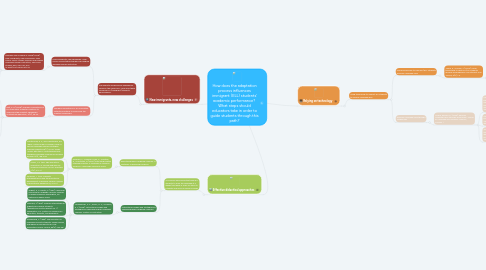
1. New immigrants, new challenges
1.1. Are diversity and persronal experiences valued in the classroom? How does these influence ELL (immigrant) students performance?
1.1.1. New immigrants, new challenges: High school social studies teachers and English language learner instruction
1.1.1.1. Seonhee Cho & Gabriel A. Reich (2008) New Immigrants, New Challenges: High School Social Studies Teachers and English Language Learner Instruction, The Social Studies, 99:6, 235-242, DOI: 10.3200/TSSS.99.6.235-242
1.1.1.1.1. Cummins, J. 1980. Psychological assessment of immigrant children: Logic or institution? Journal of Multilingual and Multicultural Development 1 (2): 97-111.
1.1.1.1.2. Harklau, L. 1994. ESL versus content-area classes: Contrasting L2 learning environments. TESOL Quarterly 28 (2): 241-72.
1.1.1.1.3. Sharkey, J., and C. Layzer. 2000. Whose definition of success? Identifying factors that affect English language learners' access to academic success and resources. TESOL Quarterly 34 (2): 352-66.
1.1.2. Teachers’ Perceptions of ELL Education: Potential Solutions to Overcome the Greatest Challenges
1.1.2.1. Batt, E. G. (2008). Teachers' Perceptions of ELL Education: Potential Solutions to Overcome the Greatest Challenges. Multicultural education, 15(3), 39-43.
1.1.2.1.1. Cummins, J. (1981b). Age on arrival and immigrant second language learning in Canada: A reassessment. Applied Linguistics, 2, 132-149.
1.1.2.1.2. Idaho State Department of Education. (2005). Student performance on state proficiency standards: 2005 state results for reading, language usage & mathematics. Boise, ID: Idaho State Department of Education.
1.1.2.1.3. Office of English Language Acquisition, Language Enhancement, and Academic Achievement for Limited English Proficient Students. (December 2004). Idaho rate of growth 1993/1994-2003/2004. [Brochure]. Washington, DC: U.S. Department of Education.
2. Effective didactical approaches
2.1. Successful approaches that allow ELL students to learn the language at a steady/fast pace in order for them to integrate and excel in regular courses.
2.1.1. Educating English Language Learners: A Synthesis of Research Evidence
2.1.1.1. Genesee, F., Lindholm-Leary, K., Christian, D., & Saunders, B. (2006). Educating English language learners: A synthesis of research evidence. Cambridge University Press.
2.1.1.1.1. Chesterfiled, R. A., and Chesterfield, K.B. 1985a. Natural order in children's use of second language learning strategies. Applied Linguistics 6(1), 45-59. 1985b. "Hoja's with the H": Spontaneous peer teaching in bilingual classrooms. Bilingual Review 12(3), 198-208.
2.1.1.1.2. Collier, V.P. 1987. Age and rate of acquisition of second language for academic purposes. TESOL Quarterly 21(4), 617-41.
2.1.1.1.3. Cummins, J. 1979. Linguistic interdependance and the educational development of bilingual children. Review of Educational Research 49, 222-51.
2.1.2. Instructional Models and Strategies for Teaching English Language Learners.
2.1.2.1. Moughamian, A. C., Rivera, M. O., & Francis, D. J. (2009). Instructional Models and Strategies for Teaching English Language Learners. Center on Instruction.
2.1.2.1.1. August, D., & Hakuta, K. (1997). Improving schooling for language-minority children: A research agenda. Washington, DC: National Academy Press.
2.1.2.1.2. Genesee, F. (1999). Program alternatives for linguistically diverse students (Educational Practice Report No. 1). Washington, DC: Center for Research on Education, Diversity, and Excellence
2.1.2.1.3. Goldenberg, C. (1996). The education of language-minority students: Where are we, and where do we need to go? The Elementary School Journal, 96(3), 353–361.
3. Relying on technology
3.1. Using technology to support ELL students to develop language skills
3.1.1. Using Technology to Help ESL/EFL Students Develop Language Skills
3.1.1.1. Ybarra, R., & Green, T. (2003). Using technology to help ESL/EFL students develop language skills. The Internet TESL Journal, 9(3), 1-5.
3.1.1.1.1. Cordova, D. & Lepper, M. (1996). Intrinsic motivation and the process of learning: Beneficial effects of contextualization, personalization, and choice. Journal of Educational Psychology, 88 (4), 715-730.
3.1.1.1.2. Kang, S.H. & Dennis, J.R. (1995). The effects of computer-enhanced vocabulary lessons on achievement of ESL grade school children. Computers in the Schools, 11 (3), 25-35.
3.1.1.1.3. Liaw, M.L. (1997). An analysis of ESL children's verbal interaction during computer book reading. Computers in the Schools, 13 (3/4), 55-73.
3.1.2. Develop Language Skills through Technology
3.1.2.1. Hoque, Enamul M., (2005). Develop Language Skills through Technology. Journal of Language and Learning. Voume 5, Number 1.
3.1.2.1.1. Case, C. & Truscott, D. (1999). The lure of bells and whistles: Choosing the best software to support reading instruction. Reading and Writing Quarterly: Oversoming Learning Difficulties, 15 (4), 361-369.
3.1.2.1.2. Lewis, P. (1997). Using productivity software for beginning language learning÷Part 1. The word processor. Learning and Leading with Technology, 24 (8), 14-17
3.1.2.1.3. Trenchs, M. (1996). Writing strategies in a second language: Three case studies of learners using electronic mail. The Canadian Modern Language Review, 52 (3), 464-497.

